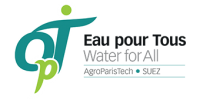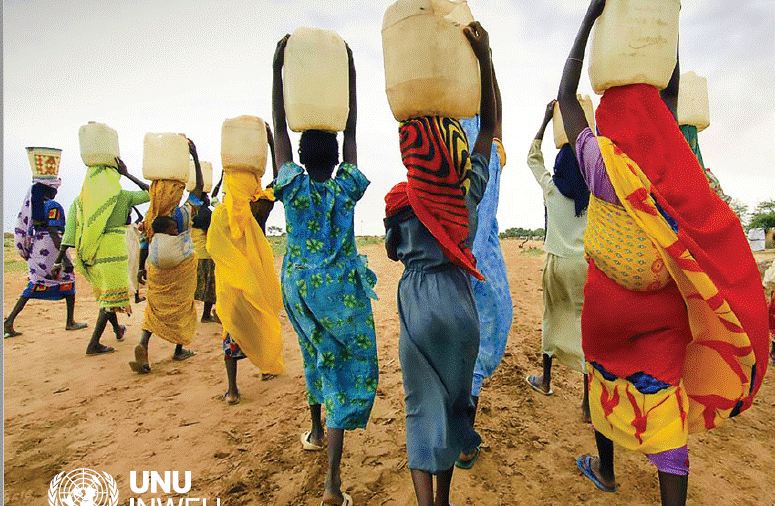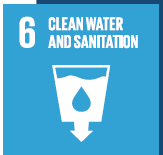UN Water Experts: The World is Off-Track to Meet Its Sustainable Water Goal by 2030
3 out of 4 people currently live in water-insecure countries. More people die from a lack of safe drinking water, sanitation, and hygiene (WASH) services than water-related disasters, reveals the new UN global water security assessment.
New York, USA: A global water security assessment led by United Nations water experts found that the majority of the world’s population currently live in water-insecure countries. This is a cause for major concern because water security is fundamental to development.
This global assessment released on the second day of the UN 2023 Water Conference provides a multidimensional comparison of the state of water security affecting 7.8 billion people across 186 countries midway into the Water Action Decade (2018-2028) and the 2030 Agenda for Sustainable Development. The report provides some very alarming statistics, arguing that the world is far from achieving “clean water and sanitation for all” known as Sustainable Development Goal (SDG) 6.
“Without water security, countries are simply incapable of supporting freshwater ecosystems, livelihoods and human well-being,” said Dr. Charlotte MacAlister, the report’s lead author and senior water security researcher at the United Nations Institute of Water, Environment and Health (UNU INWEH). “This global assessment highlights significant development challenges that policy discussions should centre on in the seven years left to fulfill SDG 6.”
Based on the assessment published by the UNU INWEH, known as the UN Think Tank on Water, policymakers are mainly focused on water scarcity mitigation around the globe. The authors argue that this reductionist interpretation of water security has put the world off-track to meeting SDG 6 by 2030.
To provide a more realistic understanding of the water security status around the world, this UN report evaluated water security on 10 components or dimensions: drinking water, sanitation, good health, water quality, water availability, water value, water governance, human safety, economic safety, and water resource stability. The results are worrying: 78% of the global population (6.1 billion people) presently live in water-insecure countries.
UNU INWEH’s Director, Professor Kaveh Madani, noted the value of this first global outlook of water security as “a major contribution” to the UN 2023 Water Conference taking place from March 22-24 in New York. “While not an easy undertaking, this research identifies where we should target policy, funding, and action to accelerate progress, meet the 2030 Agenda and ensure that the most vulnerable and insecure are not left behind.”
The global assessment’s key findings include:
While all regions have countries with low levels of water security, Least Developed Countries (LDCs) and Small Island Developing States (SIDS), in particular, face critical levels of water security due to a range of compounding factors. A total of 23 countries – 16 LDCs and 7 SIDS – are critically water-insecure: the Solomon Islands, Eritrea, Sudan, Ethiopia, Vanuatu, Afghanistan, Djibouti, Haiti, Papua New Guinea, Somalia, Liberia, St Kitts & Nevis, Libya, Madagascar, Pakistan, South Sudan, Micronesia, Niger, Sierra Leone, Yemen, Chad, Comoros and Sri Lanka.
In total, 33 countries from three geographic regions are water-secure. Sweden is the most water-secure country, along with other European countries include Denmark, Luxembourg, Austria, Norway, Switzerland, Finland and Iceland, Ireland, France, Lithuania, Greece, Germany, the UK, Estonia, Italy, Latvia, Spain, Slovakia, Slovenia, Croatia, Czechia, Hungary, and Portugal. Water-secure countries in the Asia Pacific are New Zealand, Cyprus, Australia, Japan, Israel, Kuwait, and Malaysia. Canada and the USA are the only countries in the Americas to make it into the water-secure group in the Americas.
Abundant natural water availability does not necessarily ensure water security. Many countries in Africa, the Asia-Pacific, and the Americas with abundant freshwater resources have high rates of WASH-attributed deaths due to limited WASH access, poor water quality and water having low economic value despite potentially high economic losses due to floods or droughts.
Access to safely managed drinking water and sanitation is still a pipe dream for more than half the global population. More than 70% (close to 5.5 billion) do not have safe water access, with Africa having the lowest levels of access, at only 15% of the region’s population.
Africa has the lowest levels of safe WASH services worldwide, contributing to low levels of water security in the region. Almost 31% (over 411 million) of people in the 54 African countries, including 33 LDCs and 6 SIDS, do not have access to a basic drinking water service. Only 201 million people (15%) have access to safely managed drinking water. In the case of sanitation services, 1.1 billion (82%) still live without access to a safely managed sanitation service.
Consequently, more people die from a lack of safe WASH services globally than those killed in water-related disasters. And, alarmingly, this situation is not improving: 2019 saw increased rates of WASH-attributed mortality in 164 countries compared to previous 2016 World Health Organization estimates.
Comprehensive and accurate water quality assessment at the national level remains a challenge despite a dedicated SDG 6 target. The level of domestic wastewater treatment, assessed by WHO using household sanitation statistics, remains very poor (below 30%) in Africa and large parts of the Asia-Pacific, and poor (below 50%) in most South American countries, though there are exceptions in all regions.
Water Use Efficiency does not always translate into water security. Many national economies dominated by petroleum and mining activities have a high economic value per unit of water used (100 USD/m3 or higher), but this does not necessarily result in increased water security in other components such as water governance, WASH, or human safety.
Countries at risk of floods and droughts have compounded challenges that threaten their economic safety. By region, Africa has the highest number of countries at high risk of floods and droughts, while also experiencing accelerated population growth, urbanization and industrialization. Coupled with poor infrastructure and capacity to manage the impact of water-related disasters, this further increases water insecurity.
Impacts of climate change are not accounted for in water-related SDGs, even though countries with high interannual freshwater variability worldwide, experience less stable and reliable water availability. At the same time, options to mitigate this variability through a range of water storage options are poorly represented in global policy agendas.
Monitoring progress towards the water SDGs is essential to targeting policy, funding and action. The assessment highlighted the poor state of data availability on a number of global water development indicators. Action must be taken by all national governments to radically improve data collection, and international agencies and UN data custodians have a duty and responsibility to ensure this occurs.
Unless radical action is taken, this assessment indicates that two-thirds of the world’s population will continue to live water-insecure well beyond 2030.
UNU-INWEH
The UNU Institute for Water, Environment and Health is a member of the United Nations University family of organizations. It is the UN Think Tank on Water created by the UNU Governing Council in 1996. UNU-INWEH is hosted by the Government of Canada and McMaster University, Hamilton, Ontario.
Abstract on sanitation (page 23)
Component and Indicator Background: Provision of basic to safely managed sanitation
Ensure availability and sustainable management of water and sanitation for all
Target 6.2
By 2030, achieve access to adequate and equitable sanitation and hygiene for all and end open defecation, paying special attention to the needs of women and girls and those in vulnerable situations.
Indicator 6.2.1
Proportion of population using (a) safely managed sanitation services and (b) a hand-washing facility with soap and water.
Without safely managed sanitation that separates people from excrement it is almost impossible to maintain a safe drinking water supply. Safe sanitation and drinking water (Component 1) are essential to establishing a hygienic environment good health and well-being (Component 3).
As noted, achieving universal access to water and sanitation for all is an obligation of all states (UN OHCHR), defined and monitored by CESCR. Yet in 2000, at the start of the MDG era, 71% of the global population did not have access to safely managed sanitation (almost 4.4 billion people) (JMP data, 2022). In 2015, when the SDGs were adopted, 53% (over 3.9 billion people) lived without safe sanitation (JMP data, 2022). SDG 6.2 aims to achieve access to adequate and equitable sanitation and hygiene for all by 2030 (Box 2).
Progress towards indicator 6.2.1a is assessed by the proportion of the population using a safely managed sanitation service defined as ‘an improved sanitation facility, not shared with other households, where excreta are safely disposed of in situ or removed and treated off-site’. Improved sanitation facilities ‘hygienically separate human excreta from human contact’, including wet sanitation technologies such as flush and pour flush toilets connected to sewers, septic tanks or pit latrines, and dry sanitation technologies such as dry pit latrines with slabs, ventilated
improved pit latrines, and composting toilets (6.2.1a metadata; WHO and UNICEF, 2021). Progress to achieving this target forms Component 2 of this assessment. SDG 6.2 has a second indicator, 6.2.1b, which follows from sanitation access, represented as the proportion of the population with access to soap and water for handwashing. Indicator 6.2.1b is not addressed explicitly in this assessment. Handwashing is implicit in basic hygiene and is addressed in the consequences of inadequate WASH access in Component 3.
Safe sanitation is essential to a healthy population and is foundational to all other aspects of social and economic development, the SDGs, and national water security. Yet, according to the most recent global data for 2020, five years into the SDGs, over 3.5 billion people still lack safely managed sanitation. If the trend established in 2000 continues, 2.81 billion will lack safe sanitation in 2030 (JMP WASH data 2000-2020; UNDESA 2030 population of 8.5 billion). The WHO and UNICEF JMP managed data indicates that achieving the 2030 SDG target 6.2 of universal access requires a four-fold increase in the current rate of progress. Without such an effort, progress in other SDGs will be affected.
Primary data sources and indicator data selected: Provision of basic to safely managed sanitation
WHO and UNICEF are the global monitoring and data custodians for SDG 6.2. As described in Component 1, the WHO and UNICEF JMP have reported country, regional, and global estimates of progress on WASH targets since 1990 (WHO and UNICEF, 2022). The extensive JMP global database includes data for 2000-2020.
The JMP defines the household level of WASH services across a broad ‘service ladder’, from essentially no service, to unimproved, limited, and basic to safely managed. SDG indicator 6.2.1a indicator is ‘safely managed’ sanitation, requiring facilities not shared with other households, where excreta are safely treated either in-situ or removed and treated off-site. ‘Basic’ facilities that are improved and not shared, but not safely treated, are next on the service ladder, and the service is considered ‘limited’ if shared with other households. Next are ‘unimproved’ facilities (e.g., bucket or pit toilet, no slab), and finally, ‘open defecation’ is equivalent to no service at all.
The SDG indicator is the proportion of the population using ‘safely managed’ sanitation, the highest level of the service ladder. Where available, JMP provides data for all levels of the service ladder and country progress towards the components of a safely managed service provided, reflecting the accessibility, availability, and safety components of the CESCR key elements (Introduction and Component 1). This makes it possible to see where improvements are needed to achieve ‘safely managed’ and proximity to water security. This assessment allows for the progression from basic to safely managed service by combining data for both service levels, where available, at a national level.
Of the 186 countries retained in this assessment, 112 had national data for safely managed sanitation in 2020. The 74 countries missing safe sanitation data in 2020 include 28 in Africa (4 SIDS and 15 LDCs), 20 in the Americas (14 SIDS and 1 LDC), 7 in the Asia-Pacific (7 SIDS and 4 LDCs), and Bosnia Herzegovina in Europe. National data on ‘basic’ sanitation are available for 170 countries. Sixteen countries have no data for ‘basic’ service in 2020, including four in Africa (4 LDCs and 2 SIDS), 8 in the Americas (7 SIDS), and 4 in the Asia-Pacific (1 SIDS). There can be many reasons countries do not provide data, which might reflect the level of access to the service, such as limited human and financial resources, capacity, conflict, and since 2019, pandemic-related pressures.
For this reason, and to build as complete a picture as possible, where countries retained in this assessment had ‘no data’ for 2020, values were sought for the ‘basic’ level of service reported in earlier years. Given the uncertainty associated with supplementing data from previous years, this was done only for the ‘basic’ level of service, which was assumed to be maintained even if ‘safely managed’ levels fell. A complete list of ‘data year’ used for basic and safely managed data for each country is given in Appendix I.

Scoring Scheme Component 2:
Sanitation
Following the principle of inclusion, and cognisant that many countries that did not report national safely managed sanitation access data in 2020 but have attained some components of a safely managed service, the national score also reflects a stepwise approach. The national score from 1 to 10 for ‘provision of basic to safely managed sanitation’ is calculated as the percentage of the population with access to a basic service plus the population with access to a safely managed service, divided by two. Access to basic and safe services are each worth up to half the national score. Scores 1 to 10 are assigned in steps of 10% (Table 4). The same simple scoring scheme was used for safely managed sanitation and drinking water. Countries with only a basic level of service can score a maximum of five for Component 2.

National Water Security Scores for Component 2: Sanitation Access
The 2020 JMP data (WHO and UNICEF, 2022) used in this assessment represent the situation at a national level five years into the SDGs. The distribution of national scores for access to basic and/or safely managed sanitation in the 186 countries assessed is illustrated in Figure 2, where 1 is the lowest level of access to sanitation by the proportion of the population. Almost half (92 of the 186 countries) score 5 or lower, meaning that at least 50% of their populations have no reported access to basic or safely managed sanitation nationally. Thirty-eight countries score 3 or less, meaning that 30% of the population has access to basic or safe sanitation. Of the 186 countries assessed, only 33 scored 10, indicating they are close to or have achieved universal access to safe sanitation.
Table 5 lists the 20 countries scoring lowest in access to safe sanitation globally. Similar to drinking water, 19 of the 20 lowest scores are in Africa, but the national scores for sanitation are much lower. Rates of basic access are low, ranging from 6% to 32%. Only nine of the 20 countries have reported safely managed service at a maximum of 16% access (Niger).


Map 2 illustrates that many lowest-scoring countries are in Africa and a cluster in Southeast and Central Asia. Papua New Guinea in the Asia-Pacific and Pakistan also have low scores. While some Latin American and South Asian countries are lagging, they generally scored much higher than African countries.
Of the 54 African countries assessed, including 33 LDCs and 6 SIDS, and a population of 1.34 billion in 2020, five countries in North Africa and Djibouti scored over 5.
Egypt and Tunisia reported over 97% coverage for basic and 67% to 81% safely managed sanitation, respectively.
Libya reported 92% basic and almost 22% safely managed, Algeria reported 86% basic and almost 18% safely managed, Morocco has 87% basic and 39% safe, and Djibouti has 66% basic and 37% safely managed sanitation. While over 42% of the total population of 54 African countries (almost 600 million) had access to basic sanitation, over 58% of people (almost 780 million) did not have access.
Only 18% of people (>238 million) in Africa did have access to safe sanitation services, meeting the SDG 6.2 target, but over 82% (over 1.1 billion) still live without access to safely
managed sanitation service.
The picture is much brighter in the 36 countries in the Americas assessment, which includes 17 SIDS. Only Haiti (3), Guatemala (4), and Nicaragua (4) scored less than 5.
Of the total population of the countries assessed, over 1.02 billion, almost 92% of people (close to 937 million) have access to basic sanitation, while over 8% (41 million)
still do not. Almost 60% of people (over 612 million) have access to safe sanitation, and 40% do not (> 408 million).
Of the 57 countries assessed in the Asia-Pacific, including 11 SIDS and 10 LDCs, with a total population of over 4.67 billion, eight scored less than 5, including Papua New Guinea (1), the Solomon Islands (2), Afghanistan (3), Vanuatu (3), Timor-Leste (3), Pakistan (4), Cambodia (4) and Yemen (4). Over 82% of people (>3.85 billion) had access to basic sanitation in 2020 and over 17% of people (almost 334 million) had no basic sanitation service. Over 47% of people (almost 2.2 billion) had access to safe sanitation, while close to 53% (almost 2.48 billion) did not have access to a safely managed sanitation service.
Of the 39 European countries assessed, including a total population of over 747 million people, only Moldova scored less than 5. Over 96% of people (>720 million) had access to basic sanitation, and 82% (almost 611 million) had access to safe sanitation water. That means that almost 27 million people (3.6%) in Europe did not have access to basic sanitation services, and over 136 million people (>18%) do not have access to safely managed sanitation, failing to meet the SDG 6.2 target.
Of the almost 7.78 billion people in the 186 countries assessed, over 22% (1.71 billion) did not have access to even basic sanitation, and over 53% (4.12 billion) did not have access to safely managed sanitation services in 2020.
While this assessment focuses on national water security indicators only, JMP data show significant differences in service levels and data coverage between rural and urban populations (Component 1). The JMP’s most recent global review includes data on safely managed sanitation for 120 countries, with approximately 25% greater coverage reported for urban areas, indicating that rural areas still lag behind urban services (WHO and UNICEF, 2021).
Like drinking water, reported physical access to sanitation does not always reflect household usage, particularly when the figure reported is for the national situation.
National survey data compiled in the JMP do not capture individual demographics that describe needs according to gender, life stage, pregnancy, sexual identity, disability, or housing status (among others), representing needs, barriers, or opportunities influencing access (Caruso et al., 2021). Two critical elements of the CESCR outlined in the right to safe sanitation are ‘safe and physically accessible for all, irrespective of age, gender and physical ability’ and ‘culturally acceptable, appropriate and sensitive to gender, life-cycle and privacy requirements’. Women and girls are exposed to risk and violence due to lack of access to safely managed sanitation and the related impacts of inadequate hygiene and menstrual health (WaterAid Canada, 2018). To date, it has not been possible to assess this because gender-disaggregated data are not available in SDG assessments.








